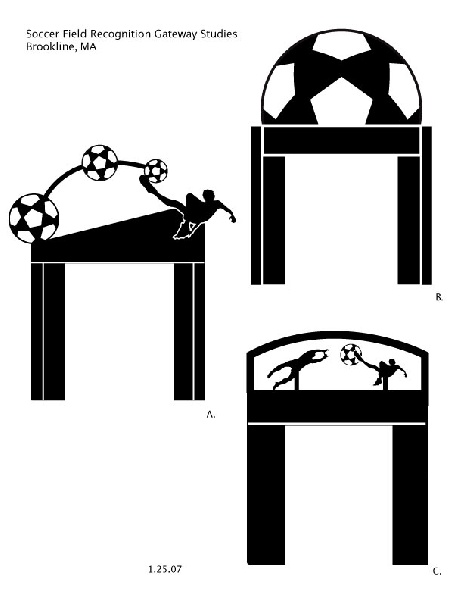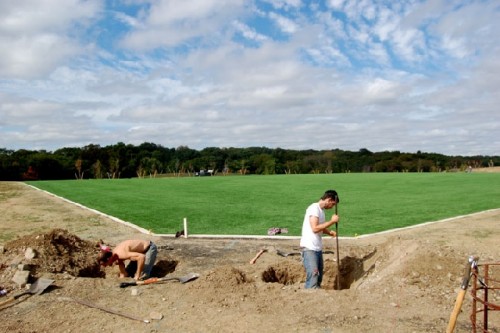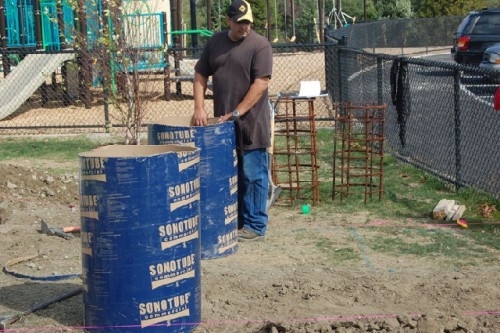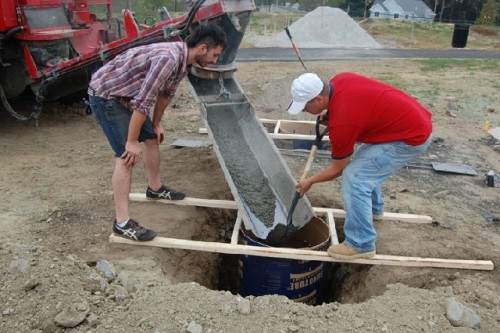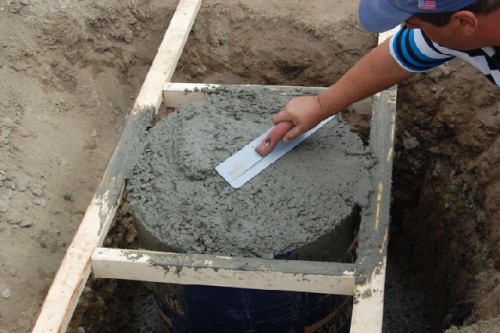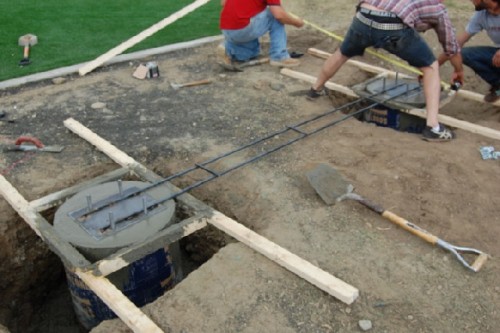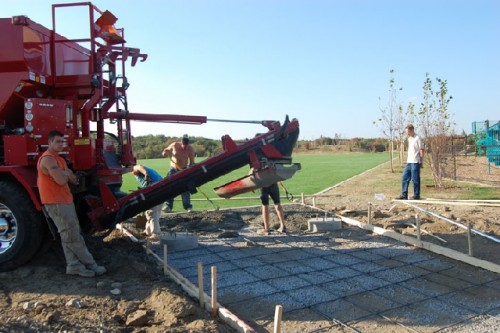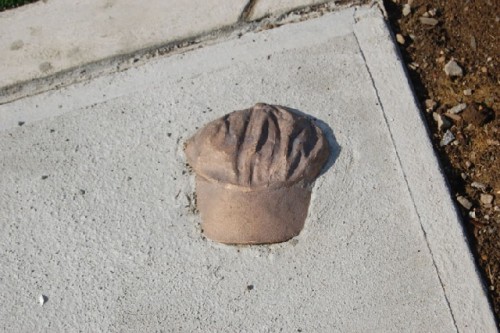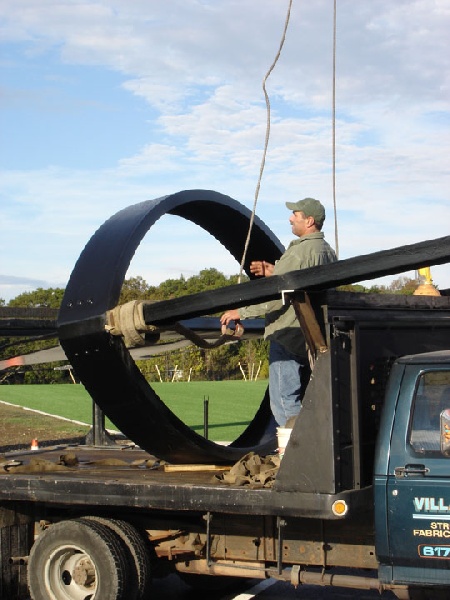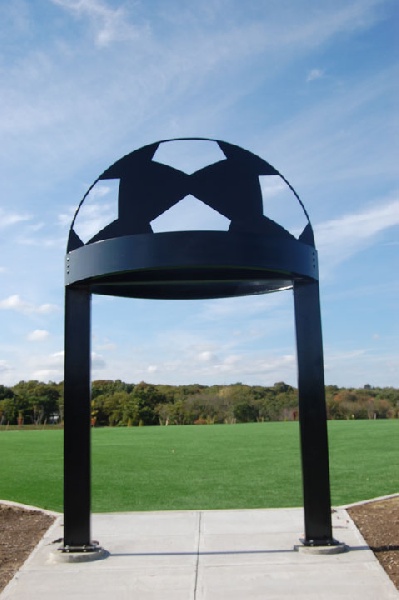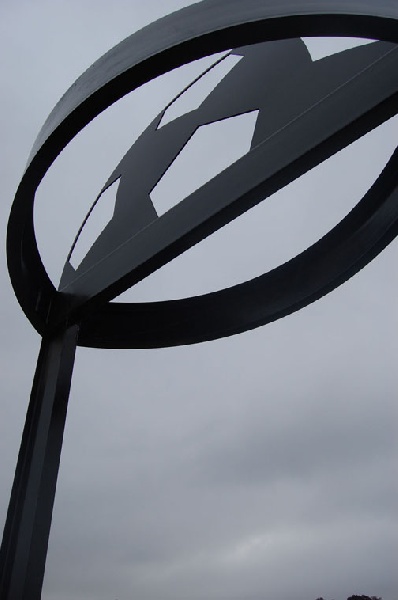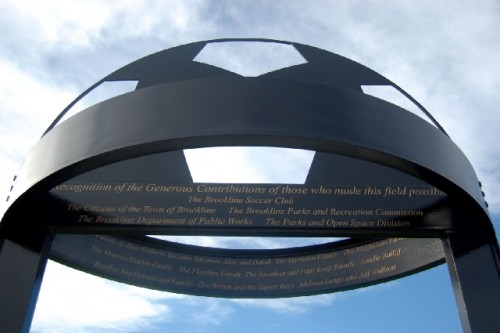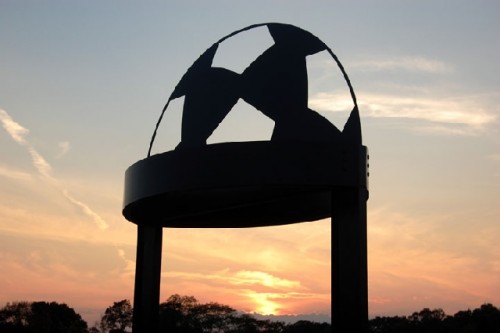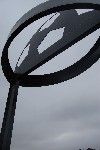Creating Public Art: A Personal View
An Artist's Perspective
By: Mark Favermann - Oct 27, 2007
Literally out of the blue sometime last January, I received a call from a prominent Boston developer. After the usual niceties, he explained that the Brookline Soccer Club, a parent organization that fostered the youth travel teams for children of the Town of Brookline, wanted a recognition piece or sign for having raised and donated $300,000 to the Town for a new soccer field. All the donors were to be recognized on it. Though the new park (the first in the town for almost 30 years) would not be ready for at least six months, he wanted me to think about an appropriate element.
I asked if they had a budget. He, in turn, asked me to develop one. As soon as the conversation was over, my heart started pumping and as Agatha Christie's Hercule Poirot said, my little grey cells started to work. Though I have had a few commissions in the last few years, public art commissions are not terribly easy too come by unless the artist is quite well-known or has a large number of previous successful commissions or both. I started to get commissions about five years ago after I created the marquee and canopy for the Coolidge Corner Theatre. I enter public art competitions rather regularly, but my rate of return has not been exceptionally high. Yet, as I have been getting public art commissions at about one per year since 2002, I guess that I am slowly starting to develop a portfolio.
Over the years, I have developed an expertise in all kinds of signage through my practice of creating and reinvigorating streetscapes as an urban designer. I had done similar types of sign and "look" projects for the 1996 Olympics in Atlanta and other major national and international sports events. For the past six seasons, I have been involved in creating the infield signs and other projects at Fenway Park. Being creative under the rigid constraints of sports corporations is always a creative challenge.
Public art to me is very different than traditional studio art. The artist is not creating work for himself, but creating work for the public. This is civic design, public enhancement of the built or natural environment. All the issues of formal design, architecture and engineering come into play with public art. Beyond aesthetics, this is problem-solving writ large. No detail is too small. No public question can be ignored. Because of the implicit character of public art, I have given my work a specific identity beyond just the aesthetics: functionality. All of my work is functioning public art. Therefore, it serves a purpose beyond and including beauty. In the past few years, I have created a theatre marquee, a public bench, a virtual gateway, a bicycle rack, lighting sconces, etc.
Each artist works differently. As my pieces are generally large and must be made to stand up to the environment, I take an atelier approach to my projects. I conceive of the project and put together a team to complete it. I actively detail it and specify how it will be made, and then I have a fabrication and installation team work with me throughout the process. For this recognition project, I was not as interested in a sign as much as I was interested in creating a gateway to the new park at the new field that allowed for signage.
For quite awhile, I have had several concepts for soccer (World football) elements. One of the few major sports events that I never worked on was the World Cup of Soccer. Sports projects have been a focus of my general design work over the last two decades. However, I have created soccer venue enhancements for the World University Games. There is a Favermann family connection to soccer. My daughter had been a wonderful player as a little girl and in high school. I even played back-up goalie on my college team. So, I started to do some rough sketches and had my student interns start building some cardboard study models. After review, more refined scale models were completed. I have found that models rather than drawings work better for clients and review committees.
The client had asked for options to choose from. I created three. Two of my initial concepts included players in them, and a soccer ball was abstractly integrated into each of the concepts. One of the options included male and female players that moved with the wind. Another basically had a player making a shot with an extended leg. The third one, and clearly my favorite, had half a soccer ball as a dome-like feature on a gateway. This one was the most abstracted in form and yet the most elegant in concept. Fortunately, the board of the Brookline Soccer Club agreed with my choice and picked the soccer ball domed gateway.
Several months had gone by and it was now April. Other models were built and refined. I took the final model to a steel fabrication plant to review potential costs. I have worked with this mill for many years on a variety of projects for clients and for myself. Structural engineers work with us to make sure safety, security and maintenance issues are seriously dealt with. Anything in the public way is cause for major public safety concern. Therefore, a public artist has to work with trusted engineers.
An interesting aspect to this project is the fact that the park and playing field are built on top of the former Town of Brookline town dump. The old incinerator was housed in the park area. The old landfill was capped to create the rather spectacular landscaped hill and natural park area. Besides the soccer pitch, there is a playground for smaller children, a pavilion for picnics and a nature trail. Strangely, neighbors abutting the area protested the park even though the newly landscaped area will probably enhance the value of their property.
A price was established and overall size of the now called "Recognition Gateway" was established. The size was to be 16.5 ft high and 10 ft wide with an 8 ft wide opening between the two steel beam posts. The general sizes of steel elements were chosen. Beams, steel plates and radius of curves and circles issues were discussed and agreed upon. My concern was that the flat plate "dome" half soccer ball should look like a volumetric rounded piece from a distance not like a flat piece of cut out plate steel. The changing sky would add to the visual sense and quality of the piece.
Interestingly, when the engineering drawings were sent to me for review, the pentagon cutout shapes were drawn as regular shapes not rounded as my earlier drawings and models had shown. I corrected this on the shop drawings and sent them back to steel fabricator. Concurrently, I had a number of meetings with the Director of the Parks and Open Space Division of the Town of Brookline's Department of Public Works first with members of the Brookline Soccer Club's board and then privately. Also in attendance was the in-house landscape architect.
Then I was asked to present to the Town of Brookline's Parks and Recreation Commission for the appointed commissioners to review the project. The commission unanimously approved the project under the condition that some acknowledgement be given to the other sports that would also be eventually played on the field as well. I spent several days thinking about how to modify the design to accommodate other sports symbols or apparatus.
Nothing that I sketched seemed to work; the gateway was a whole and complete entity. Adding to it diminished it aesthetically. Finally, it hit me. Kids leave behind all kinds of things on a playing field: sports apparatus, hats, socks, balls, broken things, etc. So, I came up with the idea of placing bronze castings of objects that kids left behind to represent childhood and other sports. The bronze castings would be placed in the concrete pad adjacent to the gateway.
At its next meeting, the commissioners approved my idea. Twelve objects were chosen to be bronzed. There were a couple of types of shoes jncluding a cleat shoe and one of my own NuBalance shoes, a Lacrosse glove, a baseball cap, a piece of a water bottle, a damaged Lacrosse stick and a broken field hockey stick, a couple of balls, a shin pad and even a pair of socks along with a deflated Rugby ball.
It should be noted that artists borrow from other artists. This can be considered high flattery. Artist Mags Harries used bronze castings at Boston's Haymarket and the Porter Square Subway Station in Cambridge many years ago to great success. Other artists have used this technique in many ways as well. Sports objects for making into castings were given to me by the Brookline High School equipment manager. This act of generosity saved much time and effort that would have resulted in a prolonged scavenger hunt. I am indebted to him.
Castings were made in a local foundry. Stainless steel rod was welded to each object to hinder theft and vandalism. The two curved steel beams were bent at a mill in Chicago. The plate steel was hand cut by welding torches. Until the park was ready, installation was delayed until early October.
The actual final site for the gateway changed several times. It started at the top of the hill over an adjacent pathway to the soccer field. This was unacceptable to me because there was to be a bollard (metal post) in the middle of it. Then there was an alternative site at the bottom of the hill on the side of the entrance road. The Brookline Soccer Club was not happy with this one. Then it was moved back to the top of the hill adjacent to the field but set at an angle. This was shifted to the final site adjacent to the corner of the field set as an entrance. A concrete pathway about 20 feet long was to be under the Recognition Gateway.
Installation was arranged for Friday, October 5, but the field's turf (the same type used at Gillette Stadium for the Patriots in Foxboro, MA) was not set down yet. October 9 was the actual installation. Prior to that, concrete footings had to be prepared and poured on October 3. All the sizing and pour amounts were worked out by the structural engineer in advance of the actual pour date.
Initially holes are dug for placement of Sunotubes, the thick walled cardboard cylinders that are used for construction sites for sampling and for testing of material strength. In this case the diameter was 3 ft. and the depth was 42 inches to give the proper stability to the Recognition Gateway structure. When the concrete was poured and had set for a while, bolts were set within the cylinders. They were measured and re-measured by placing a metal template the exact length of the piece that assured that the bolts were in exact alignment.
Then a trough was dug out and steel rod was tied in place with metal wire to set the concrete pad. After the concrete was poured and spread by several workers, my assistant, Emmett Burson, a talented artist/industrial designer in his own right and I set the bronze castings in place. We pushed them into the still wet concrete mix. Then we left to wait for them to harden in place.
On the morning of October 9 at 8 AM, the truck finally rolled up the hill. On the back of the flatbed was my gateway lying on its side. There was a flexible crane behind the truck's cab. The truck backed up to the concrete pad, the crane arm was attached by canvas cords in two places to the gateway and lifted it up in the air. Three men on the ground directed the floating piece into alignment with the set bolts. It fit exactly. The bolts had nuts wrenched on them, and then my sculpture was standing vertically. Of course, various touch-ups on the gateway itself were needed and refinements to the concrete pad as well as to the bronzes would be necessary. But that is part of the public art process and expected.
Not surprisingly, there was a bit of politics between the private soccer club and the Town, but I was able to act as a liaison, even mediator between them and get the project completed. The last act was to add the names of the donors. It was agreed that gold lettering would be affixed to the structure to recognize each of the prominent donors. The font chosen was readable as well as elegant. As I designed it, the lettering was to be set on the inside of the gateway in a place that cannot be easily reached in order to protect against vandalism. This was also a method to best integrate the lettering with the gateway structure.
The first soccer game was played at the new field on October 17. The highly ranked Brookline High School Boys Varsity inaugurated the soccer pitch. It was gratifying to hear parents and even a few players complement and congratulate me on the gateway. The opposing losing team seemed to ignore it or at least pretend not to even see it.
The members of the Brookline Soccer Club seem happy, My clients were quite supportive and encouraging, even rather visionary. The Town of Brookline staff and commissioners seem happy. In fact the Brookline Parks Commission and town staff couldn't have been better to work with throughout the whole process. Parents of soccer players seem to be happy. I am even happy.
All in all, this was one of the smoothest public art projects that I have ever been involved with. There will be an official dedication ceremony for the park and the Recognition Gateway sometime in the Spring of 2008 when all the plantings are green and the park is visually more complete. Though I got a fee, completing the piece was my true reward.

